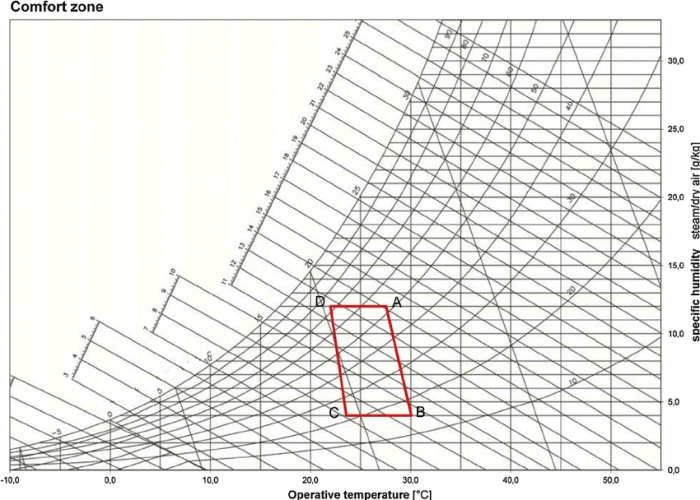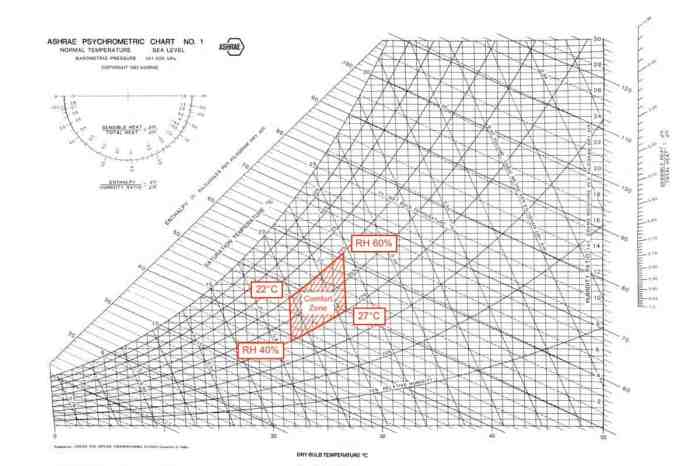Comfort zone in psychrometric chart – The comfort zone in a psychrometric chart, a graphical representation of the relationship between temperature, humidity, and air velocity, is a crucial aspect of thermal comfort in buildings. This zone defines the range of conditions where occupants feel comfortable and productive, and maintaining it is essential for occupant health and well-being.
This comprehensive guide explores the concept of the comfort zone in psychrometric chart, examining the factors that influence it and the methods used to maintain it in buildings. Additionally, the relationship between the comfort zone and energy efficiency is discussed, providing strategies for optimizing thermal comfort while minimizing energy consumption.
Comfort Zone on Psychrometric Chart
The comfort zone on a psychrometric chart is the region where the combination of temperature and humidity is perceived as comfortable by most people. It is typically defined by a range of temperatures between 18-24°C (64-75°F) and a relative humidity between 40-60%.
The comfort zone is determined based on the human body’s ability to regulate its internal temperature and maintain thermal equilibrium.
The psychrometric chart is a graphical representation of the thermodynamic properties of moist air, including temperature, humidity, and enthalpy. The comfort zone is typically depicted as a shaded area on the chart, indicating the range of conditions that are considered comfortable for human occupancy.

Factors Affecting Comfort Zone

The comfort zone is influenced by several factors, including:
Temperature
Temperature is the most significant factor affecting comfort. The human body is most comfortable within a narrow range of temperatures, typically between 18-24°C (64-75°F). When the temperature is outside this range, the body must work harder to maintain its internal temperature, leading to discomfort.
Humidity
Humidity is the amount of water vapor in the air. When the humidity is too high, the air feels muggy and uncomfortable. This is because the body has difficulty evaporating sweat to cool down. Conversely, when the humidity is too low, the air feels dry and can cause irritation to the skin and respiratory system.
Air Velocity
Air velocity refers to the speed and direction of air movement. A gentle breeze can help to dissipate body heat and increase comfort. However, excessive air velocity can cause drafts and discomfort, especially when combined with low temperatures.
The following table summarizes the effects of different factors on the comfort zone:
| Factor | Effect on Comfort |
|---|---|
| Temperature | Too high: Discomfort due to increased body temperature |
| Too low: Discomfort due to decreased body temperature | |
| Humidity | Too high: Discomfort due to difficulty evaporating sweat |
| Too low: Discomfort due to dry skin and respiratory irritation | |
| Air Velocity | Gentle breeze: Increased comfort due to heat dissipation |
| Excessive air velocity: Discomfort due to drafts |
Maintaining Comfort Zone in Buildings: Comfort Zone In Psychrometric Chart

Maintaining the comfort zone in buildings is essential for occupant health and productivity. Several methods are used to achieve this, including:
Heating, Comfort zone in psychrometric chart
Heating systems are used to raise the temperature in a space during cold weather. This can be achieved through various methods, such as central heating systems, electric heaters, or fireplaces.
Cooling
Cooling systems are used to lower the temperature in a space during hot weather. This can be achieved through methods such as air conditioning, evaporative coolers, or natural ventilation.
Ventilation
Ventilation is the process of exchanging indoor air with outdoor air. It helps to maintain a comfortable humidity level and remove pollutants from the indoor environment. Ventilation can be achieved through natural means (e.g., open windows) or mechanical means (e.g.,
exhaust fans).
Technologies such as variable air volume (VAV) systems and building automation systems (BAS) are used to control the comfort zone in buildings by adjusting heating, cooling, and ventilation based on occupancy and environmental conditions.
Comfort Zone and Energy Efficiency
Maintaining the comfort zone in buildings can impact energy consumption. When the comfort zone is not maintained, occupants may adjust thermostats to extreme settings, leading to increased energy use. By optimizing the comfort zone, energy consumption can be reduced without compromising occupant comfort.
Strategies for optimizing the comfort zone while minimizing energy use include:
- Using energy-efficient heating and cooling systems
- Implementing passive design strategies to reduce heating and cooling loads
- Utilizing natural ventilation to reduce the need for mechanical cooling
- Educating occupants on the importance of maintaining the comfort zone and avoiding extreme thermostat settings
Popular Questions
What is the comfort zone in a psychrometric chart?
The comfort zone is the range of temperature and humidity conditions in which most people feel comfortable and productive.
How is the comfort zone determined?
The comfort zone is determined based on factors such as temperature, humidity, air velocity, and personal preferences.
Why is it important to maintain the comfort zone in buildings?
Maintaining the comfort zone is important for occupant health, productivity, and well-being.